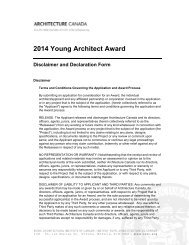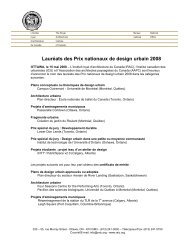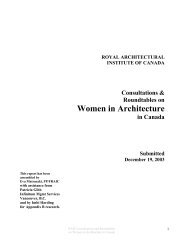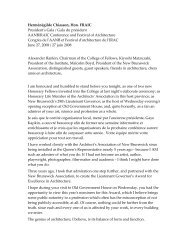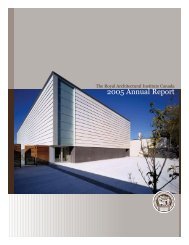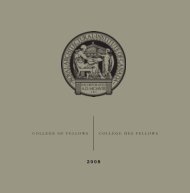Benchmark Study on Green Buildings - Royal Architectural Institute ...
Benchmark Study on Green Buildings - Royal Architectural Institute ...
Benchmark Study on Green Buildings - Royal Architectural Institute ...
You also want an ePaper? Increase the reach of your titles
YUMPU automatically turns print PDFs into web optimized ePapers that Google loves.
c<strong>on</strong>ducting research and experiments c<strong>on</strong>cerning waste minimizati<strong>on</strong> during building and<br />
dismantling stages, advanced building material recycling techniques, l<strong>on</strong>g-term durability<br />
studies, and envir<strong>on</strong>mental assessments of various building materials.<br />
Envir<strong>on</strong>mental Activity Evaluati<strong>on</strong> Program:<br />
The Japanese Ministry of the Envir<strong>on</strong>ment has released its Envir<strong>on</strong>mental Activity<br />
Evaluati<strong>on</strong> Program guidelines and made them available <strong>on</strong>line to help people c<strong>on</strong>duct<br />
envir<strong>on</strong>mental self-assessments of their homes, businesses and activities. Although there<br />
is no quantitative aspect to the guidelines, they are fairly comprehensive and if the<br />
assessment is d<strong>on</strong>e properly, it can lead to the identificati<strong>on</strong> of areas needing<br />
improvements in order to save resources, reduce polluti<strong>on</strong>, increase energy efficiency, etc.<br />
The assessment takes the form of a plan-do-check-act procedure and promotes c<strong>on</strong>tinual<br />
improvement. The guidelines are available <strong>on</strong>line at http://www.env.go.jp/policy/jhiroba/PRG/pdfs/e_eco_acti<strong>on</strong>.pdf.<br />
The Ministry of the Envir<strong>on</strong>ment’s website has more<br />
specific guidelines and assessment standards available for a variety of green building<br />
areas including noise polluti<strong>on</strong>, recycling and waste management, air quality,<br />
transportati<strong>on</strong>, site characteristics such as heat islands, etc. They can be found at<br />
http://www.env.go.jp/en/ through the navigati<strong>on</strong> bar <strong>on</strong> the bottom left of the page.<br />
Yanepita Photovoltaic Systems:<br />
Japan also has numerous initiatives being carried out by private companies. In 2003, as<br />
<strong>on</strong>e of its series of “Sunbest” photovoltaic systems, Matsushita Electric Works Ltd. of<br />
Japan launched sales of the “Yanepita,” a PV power generati<strong>on</strong> system that is specially<br />
designed for installati<strong>on</strong> <strong>on</strong> the slate tile roofs of existing houses. When installing a PV<br />
system <strong>on</strong> slate roofs using c<strong>on</strong>venti<strong>on</strong>al methods, it was difficult to overcome problems<br />
of the systems developing rain leaks and being blown off by the wind. To overcome these<br />
problems, Yanepita involves installing special bases <strong>on</strong> the existing slate roofing and then<br />
the ultra-thin solar modules, <strong>on</strong>ly ten millimeters thick, <strong>on</strong> top of the bases. Since its<br />
height above the tiles is <strong>on</strong>ly 40 millimeters, the system has no negative effect <strong>on</strong> the<br />
appearance of houses. In additi<strong>on</strong>, the system excels in durability, waterproof and<br />
windproof qualities. The company says that the system can be easily installed <strong>on</strong> alreadybuilt<br />
houses. The outer dimensi<strong>on</strong>s are 1,191 x 792 millimeters, and as each panel is<br />
independent, installati<strong>on</strong> of the system can be flexible depending <strong>on</strong> the shape of the roof.<br />
Residential geothermal heat pumps:<br />
Sunpot Co., a heating appliance maker in Japan, and Hokkaido University have codeveloped<br />
a geothermal heat pump unit and in 2004 became the country’s first<br />
manufacturer to start mass-producti<strong>on</strong> of residential geothermal heating units. The system<br />
involves digging a hole in the ground about 10 centimeters in diameter, 75 to 100 meters<br />
deep, and inserting a polyethylene pipe filled with an antifreeze soluti<strong>on</strong>. The system<br />
absorbs ground heat as a thermal source for the heated water system. Ground heat is a<br />
stable natural energy source that takes advantage of ground temperatures c<strong>on</strong>sistently two<br />
degrees Celsius warmer than the local average annual air temperature, unaffected by<br />
heavy snow or variati<strong>on</strong>s in surface air temperatures. The new heat pump can produce the<br />
equivalent of four times more heat energy than the electricity the system c<strong>on</strong>sumes. The<br />
system is not <strong>on</strong>ly energy efficient but also helps reduce fossil fuel c<strong>on</strong>sumpti<strong>on</strong>,<br />
90



